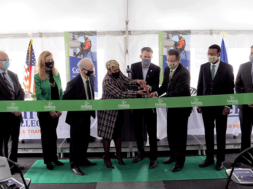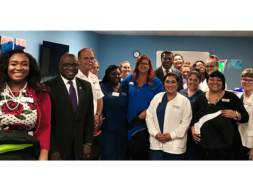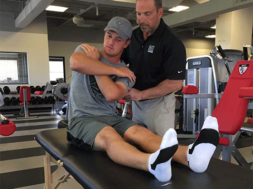
The Edtech Shift Without the Educator Shuffle: A Low-Stress Action Plan to Nurture Faculty’s Intelligent use of Educational Technology
By Bridgett McGowen-Hawkins, Senior Digital Educator for the Western Region, Cengage Learning
Ubiquitous little gizmos they are. Smart phones. Tablets. Laptops. Everyone has them, and everyone relies on them in virtually every facet of life. As such, it is perfectly reasonable to expect its permeation of the post-secondary world, right? Not so fast.
Higher education administrators across the country remain on an unceasing quest to locate then implement resources and practices to position their institutions as the best. In recent years, an undeniable resource and practice has been educational technology and faculty’s effective use of it. Research tells faculty to add edtech to their teaching, colleagues encourage faculty to include it, and everyone cites empirical evidence for how doing so makes undeniable differences in student success. However, at the same time, administrators want to ensure faculty embrace the culture of adding edtech not simply because, according to the Pew Research Center, 98 percent of people between the ages of 18 and 29 own a cell phone (“Mobile”) or because students gather with friends on Skype as opposed to at the local park (“2018 list”) but that its addition is done for all the right reasons.
As such, three levels of responsibility are in the hands of post-secondary administrators who are positioned to move their faculty to incorporate edtech into their instruction:
- Assist faculty with determining which technology tools to put in place;
- Guide faculty with understanding how specific edtech selections further course objectives and student learning; and
- Empower faculty to overcome obstacles that might limit their current use of edtech.
Discussion
Twenty-first century education finds itself situated in the midst of a society replete with digital options, a staggeringly vast collection of clickable resources for teaching and learning, and the prospect of narrowing options to make intelligent selections can seem virtually impossible. An overwhelmingly rich pool of edtech tools may be the culprit for what happens next.
Oftentimes the message to faculty includes an explanation of the gamut of learning and teaching possibilities that accompany edtech’s incorporation into the classroom and an insistence that they explore their options;
the problem with this approach is faculty hear the message but are unsure of where to start or how to wisely spend their time researching and testing tech tools; in short, they need to see select tools and know their power and potential (Surry, 2000).
Simply put, talking about edtech is not synonymous with showing edtech, and giving faculty carte blanche to seek and discover edtech avenues may prove futile for some teams as they aimlessly venture out, shuffling about in multiple directions, unclear of what to try. To increase the likelihood faculty will embrace and use any piece of technology, they must hear about it as well as see it in action and have an opportunity to make inquiries that lead to clarifying the tool’s benefits. In order to minimize the confusion, stress, and complication when transitioning faculty to include technology in the classroom in smart ways, simplicity is vital.
Start with an edtech team
Ideally, start with an edtech team; this is a small cadre of faculty members identified by administration as those with an urge and ability to curate edtech tools that speak to the institution’s goals and mission and those who have integrated edtech into their teaching with great success. Naturally, each institution defines its owning meaning of “success;” for the purpose of this reading, success equates to high levels of engagement, academic performance, and satisfaction as experienced by the student.
Additionally, those members of the edtech team should be ones who are sensitive to the technologically challenged and who are able to facilitate communication and coaching (Brown, Benson, & Uhde, 2004 in Georgina, & Hosford, 2009).
This edtech team starts by each member identifying at least one edtech tool he/she will incorporate into one or more of his/her courses. They can all use the same tool or different tools; however, an array of tools is preferred as a means for suggesting to the rest of the faculty they not limit themselves to only one option. The team should journal about its experiences with the tools, identifying what worked well, what fell below expectations, what features might be nice to have in an edtech tool, and what tools should be on the horizon.
Questions for edtech team journaling might include the following: Did students perform better after the addition of a certain tool? Were classroom discussions richer? How so? Did test scores improve? Did conversations about the course content extend beyond the classroom’s four walls as a result of using technology? If so, in what ways? Were students more eager to arrive to class? How did the quality of homework submissions change? In addition, perhaps a campus has goals and initiatives to which the edtech team can specifically speak. The team could journal responses to questions such as:
- How did the use of the edtech tool further X initiative?
- What implications does the use of the edtech tool have for meeting Y goal?
- Based on this experience, what other kinds of edtech tools and features might we consider using with our students to further Z mission?
Regular virtual and/or face-to-face edtech team meetings should take place where members dialogue about their experience and prepare to report out to the larger team of campus faculty, explaining which edtech tools the team members integrated into their classrooms, why the team selected the tools they selected, specific actions performed by both the faculty and the students, and the results the team saw. The report may be in the form of a brief presentation to the faculty with a Q&A session, email updates, or posts to an online faculty portal.
Explain why and how edtech will make a difference
And aside from clarifying what options are available to them, faculty must also know how a respective piece of edtech will further learning and why they should find a place for it in their current teaching methodology.
Answering that question, “why,” is the primary impetus for change, movement, and excitement. If faculty know the precise andragogical*, not pedagogical, why’s fueling the request they add edtech, then their embrace of it increases exponentially. Edtech conversations should not take place in isolation; adult motivation to learn and the methodology of teaching adult learners, andragogy, are necessary elements within all faculty edtech talks (Keengwe, Kidd, & Kyei-Blankson, 2009). Here are three reasons faculty should add edtech to their current instructional practices as a means for furthering student learning:
- Edtech aids to prime students to receive what faculty have prepared to present in class. To many faculty members’ dismay, students arrive lacking the background or prior knowledge required to grasp some course concepts, and at the core of understanding new information is having a foundation of basic information. Multiple studies in past decades have proven a substantial linear relationship exists between student interest and prior knowledge, and when the interest is present, students experience a deeper type of comprehension (Tobias, 1994). However when prior knowledge and interest are absent, faculty are required to cover introductory material that takes away from time that could be spent on more involved course material. This dismay, though, can be extinguished with edtech. Have faculty imagine being able to direct students to watch a video that illustrates a course concept prior to the in-class discussion. Lectures then become transformed into conversations because now students have obtained the necessary background knowledge. By providing students with guiding questions that frame their perspectives as they view a video so they watch with purpose, then offer references to the video in the course of the in-class lectures, students are better positioned to engage in an academic discourse (McGowen-Hawkins & Givehand, 2014).
- Countless times faculty have been met with the insistence they use strategies to engage all the different types of learners in the classroom; however, this should be reexamined, for it is more of a matter of paying attention to the content rather than the recipient of the content. Simply put, some material is better presented in certain formats than others, and as such edtech proves beneficial in this endeavor to more effectively deliver course material (Chick). Visual, auditory, read/write, and kinesthetic/tactile (VARK) learners make-up today’s classroom; these are the ways by which students gather, interpret, organize, synthesize, process and make sense of information they receive. One might argue this will make sense to one student if he hears it, another if she sees it, a third if he reads about it, and a fourth if she manipulates objects applicable to the content;
however, learning is richer and more successful if the mode by which the content is delivered is dependent upon the content and not the student’s preference.
With options such as lecture casts, online discussion boards, and multi-media simulations, technology provides a platform for the speech instructor to demonstrate how an effective speech should sound, the literature or history instructor to provide applicable writing activities, and the performing arts or medical instructor to offer illustrations of course concepts.
- Although today’s students grow up in a digitally driven world surrounded by technology at nearly every turn, they are not all prepositioned to know how best to interact with technology. Students arrive in college classrooms intimately familiar with technological devices, oftentimes resulting in faculty feeling as though they must compete with the devices for students’ undivided attention; however, faculty can take advantage of this sign of the times by merging students’ digital worlds with their academic worlds by capitalizing on a unique opportunity to prepare students for the world in which they live, readying them to actively and intelligently participate in the world as it develops. Part of the work faculty perform on their respective campuses is to move students to constantly examine and reflect upon not only the information they receive but also the information they share with others. Educators’ structured use of technology in the classroom demonstrates for students what it means to responsibly use technology as a tool rather than to regularly and mindlessly tap into it without first giving conscious thought to what they are doing and why they are doing it.
Empower faculty to overcome obstacles
Finally, once faculty receive administrative assistance with determining which technology tools to put in place and guidance with understanding how specific edtech selections further course objectives and student learning, administration may still be faced with empowering faculty to overcome obstacles that might currently limit faculty’s use of edtech. Both internal and external factors preclude faculty from embracing the addition of technology to their teaching. “The most common internal factors that influence an instructor’s decision to incorporate technology in teaching are individual beliefs, feelings of anxiety, fears, preferences and perceptions and feelings of competence” while external factors are age and gender, class size, and institutional support (Osika, Johnson, & Bueau, 2009). As such, messages that make faculty feel empowered in this transition to digital are integral in successfully getting them beyond impediments – real or imagined.
First, convince faculty to get started with any small change that will involve technology; they do not have to discard the lessons they have carefully crafted over the years and start anew. They are not required to become technology power-users or transform themselves into digital experts overnight. Integrating technology into the classroom takes but a singular act of consciously identifying how they might engage students via technology.
Faculty should know technology will not replace them but that technology is meant to enhance what they already do incredibly well (Onorato & McGowen-Hawkins, 2015).
Ask faculty to think of how they already use technology in their personal lives: text and/or instant messaging, email, Facebook account updates. What purposes do these tech options serve? How do they impact faculty’s personal lives? Then, how might some iteration of their use fit into the classroom to further learning? For instance, faculty might send a question to students via text message or Facebook, requiring a response by a specified date, to assess their understanding of a concept discussed in the day’s lecture. Technology exists where faculty can have such messages privately and securely delivered to students in the platform they choose while faculty do not have to have accounts with any of those social media platforms nor do they have to “friend” or “like” students if they do have their own social media accounts; one such publisher, Cengage Learning, offers an edtech solution, MindTap, that includes this technology and other features to personalize the learning experience (www.cengage.com/mindtap).
Second, administrators should show their commitment to on-going faculty and professional development that will afford faculty with hands-on opportunities. This, faculty and professional development, is one of the most significant influences on educators’ edtech evolution (Johnson, Wisniewski, Kuhlemeyer, Isaacs, & Krzykowski, 2012). And faculty tends to thrive in a small group faculty forum led by a trainer or in one-on-one situations with colleagues (Georgina, & Hosford, 2009; Kramer, & Benson, 2013).
Professional development might include but are not limited to demonstrations and workshops from publisher representatives and their faculty development teams, co-teaching with campus colleagues who already integrate technology into the classroom, and one-on-one collaborations and conversations between faculty who have undeniable patience and passion for furthering learning through the use of edtech. With any hands-on moment, emphasize the importance of scaffolding to avoid a tool’s staggering complexity resulting in a stymieing of faculty progression, for if a tool appears too complicated, then it automatically and conveniently creates rationale for faculty to retreat and/or retain teaching practices that exclude edtech. Equally important is trainers or professional development facilitators who are sensitive to the needs of the faculty assembled before them and who consciously include periods of dialogue among the faculty (Brown, Benson, & Uhde, 2004 in Georgina, & Hosford, 2009).
Third, share with faculty that they can expect to encounter glitches, however, it is not the glitches that are the measure of success or failure; it is a faculty member’s ability to handle the glitch with grace, control, and humor that will distinguish edtech trials from edtech triumphs.
Technology is not perfect; just ask the New York Stock Exchange, United Airlines, and the Wall Street Journal when on July 08, 2015, business came to a screeching halt at all three companies because of problems with computer servers and other ‘technical issues’ (“Tech fail,” 2015). They may have been sweating behind the scenes, but all public reports were calm and collected accounts of apologies and assurances that foul play was not involved and commitments to expedient efforts to resolve the issues. Similarly, encourage faculty to work toward an expeditious fix or resort to engaging in what they know best: teaching. Transition with a joke and the promise to try the technology again later, then move on; avoid overreacting or suggesting to students through actions and words that the foundation of a class meeting is built on technology’s proper operation. Rather it is built on both faculty and students being prepared to actively engage in course dialogue.
Conclusion
Change is good! It is the “let’s get started” part that can be the challenge. Faculty members hear and learn about infinite numbers of educational technology tools and may feel some consternation about changing their tried-and-true model of teaching, a model to which they have become comfortably accustomed. Some get excited at the prospect of adding technology while others get overwhelmed, and most then find themselves in one of two camps: wanting to use everything all at once or ending up using nothing at all. Administrators are perfectly positioned to help overcome faculty obstacles that might currently limit their use of edtech tools so as to move them closer to being able to arrive at smart decisions about incorporating digital teaching tools that further course objectives and student learning.
It is not a matter of turning education into edutainment; it is a matter of evolving, improving, and creating a learning experience that is not based on what has been done the same way term after term but one that is meaningful, impactful, and creates a student who comes back hungry for more every single class session. Faculty who insist their classrooms are already at that caliber, then the argument becomes imagine how much more incredible the experience could be with the addition of a tool that has no bounds.
References
2018 list. Retrieved from https://www.beloit.edu/mindset/2018/
Chick, N. Learning styles. Retrieved from http://cft.vanderbilt.edu/guides-sub-pages/learning-styles-preferences/
Georgina, D. A., & Hosford, C. C. (2009). Higher education faculty perceptions on technology integration and training. Teaching and Teacher Education, 25(5), 690-696.
Johnson, T., Wisniewski, M. A., Kuhlemeyer, G., Isaacs, G., & Krzykowski, J. (2012, March 1). Technology adoption in higher education: Overcoming anxiety through faculty bootcamp. Journal of Asynchronous Learning Networks, 16(2), 63-72.
Keengwe, J., Kidd, T., Kyei-Blankson, L. (2009). Faculty and technology: Implications for faculty training and technology leadership. Journal of Science Education & Technology.
Kramer, S., & Benson, S. (2013). Changing faculty use of technology – one cohort at a time. Journal of Applied Research in Higher Education, 5(2), 202-221.
McGowen-Hawkins, B., & Givehand, D. (2014, January 21). Get the low-down on high-tech: Five big reasons to add technology to your teaching. [Blog post]. Retrieved from http://blog.cengage.com/author/damon-givehand/
Mobile technology fact sheet. Retrieved from http://www.pewinternet.org/fact-sheets/mobile-technology-fact-sheet/
Onorato, R. M., & McGowen-Hawkins, B. (2015, February). Dive in and learn to swim: Smart ideas to keep you afloat in the educational technology pool. Concurrent session presented at the Cengage Learning TeamUP Wired and Inspired: The Intelligent Use of Technology in Higher Education conference in Las Vegas, NV.
Osika, E. R., Johnson, R. Y., & Buteau, R. (2009). Factors influencing faculty use of technology in online instruction: A case study. Online Journal of Distance Learning Administration, 12(1). Retrieved from http://www.westga.edu/~distance/ojdla/spring121/osika121.html
Surry, D. W. (2000). Strategies for motivating higher education faculty to use technology. Innovations in Education and Training International, 37(2), 145-153.
Tech fail!: Explaining today’s 3 big computer errors. (2015, July 8). Retrieved from http://money.cnn.com/2015/07/08/technology/united-nyse-wsj-down/index.html
Tobias, S. (1994). Interest, prior knowledge, and learning. Review of Educational Research, 64(1), 37-54.
Bibliography
3 things to consider when trying new strategies. Retrieved from http://www.edutopia.org/discussion/3-things-consider-when-trying-new-strategies
50 ways to integrate technology. Retrieved from https://sites.google.com/site/anchortechnologytomorrow/home/50-ways-to-anchor-technology
2017 list. Retrieved from https://www.beloit.edu/mindset/previouslists/2017/
Antonacci, D. M (2002). Integrating technology into instruction in higher education [Doctoral dissertation]. Retrieved from http://associations.missouristate.edu/assets/mohighedweb/IS-TechnologyIntegrationinHigherEducation.pdf
Beatty, R., Givehand, D., Hurd, J., McGowen-Hawkins, B., Rivera, G., & Wolf, A. (2015, May 6). Chalk and talk the edtech walk: A Panel discussion [Webinar]. Retrieved from http://www.prolibraries.com/teamup/?select=session&sessionID=862
Bowen, J. A. (2012). Teaching naked: How moving technology out of your college classroom will improve student learning. Hoboken, NJ: Jossey-Bass.
Doorn, D., Jannssen, S., & O’Brien, M. (2010). Student attitudes and approaches to online homework. International Journal for the Scholarship of Teaching and Learning, 4(1). Retrieved from http://digitalcommons.georgiasouthern.edu/cgi/viewcontent.cgi?article=1205&context=ij-sotl
Dunn, J. (2011). The evolution of classroom technology. Retrieved from http://larrycuban.wordpress.com/2012/04/01/evolution-of-classroom-technology-jeff-dunn/Ed tech cheat sheet every educator should know about. Retrieved from http://www.educatorstechnology.com/2012/07/ed-tech-cheat-sheet-every-educator.html
Gulek, J. C. & Demirtas, H. (2005). Learning with technology: The impact of laptop use on student achievement. Journal of Technology, Learning, and Assessment, 3(2).
Harven, M. (2015, April 1). New report gives edtech trends and technologies for next five years. Retrieved from http://tinyurl.com/edtechtrends5years
Howard, B. C. (2008, October-December). Conclusion and next steps: The Edtech collaborative. International Journal of Information and Communication Technology Education (4)4, 72-76.
Johnston, T. C. (2004). Online homework assessments: Benefits and drawbacks to students. Academy of Educational Leadership Journal, 8(3), 29-40.
Juggling demands distracts today’s students from learning according to Cengage Learning/Eduventures Study. (2011, February). Retrieved from http://news.cengage.com/library-research/juggling-demands-distracts-todays-students-from-learning-according-to-cengage-learningeduventures-study/
Knezek, D. Technology and student achievement – The indelible link. International Society for Technology in Education Policy Brief. Retrieved from http://www.k12hsn.org/files/research/Technology/ISTE_policy_brief_student_achievement.pdf
Lane, C. A., & Lyle, H. F. Obstacles and supports related to the use of educational technologies: The Role of technological expertise, gender, and age. Journal of Computing in Higher Education 23, 38-59.
Onorato, R. (2012, November 6.) Assignments in the online course: How much is too much? Retrieved from http://blog.cengage.com/assignments-online-course/
Raines, J., & Clark, L. (2011, June). A brief overview on using technology to engage students in mathematics. Current Issues in Education 14(2), 21.
Saba, A. Benefits of technology integration in education. Retrieved from http://edtech2.boisestate.edu/sabaa/502/Saba_Synthesis_Paper.pdf
Shah, S; & Murtaza, A. (2012, July). An investigation into the application of educational technology at higher educational institutions. Theory and Practice in Language Studies 2(7), 1420-1429.
Who moved my chalkboard podcast series. Retrieved from http://blog.cengage.com/tag/who-moved-my-chalkboard-podcast-series/
* Oftentimes “pedagogy” is used in the higher education space when “andragogy” should be used instead. The former refers to teaching methodologies employed with children in the elementary and secondary education environments while the latter, a theory developed by Malcolm Knowles, refers to instructional practices that take into account the different needs and motivations of adult learners.

Bridgett McGowen-Hawkins is a published author, a former Texas A&M University System instructor, and a Senior Digital Educator for the Western Region at Cengage Learning. Bridgett has blogged about and designed and delivered hundreds of presentations nationally, internationally, online, and on-ground on the topics such as educational technology, post-secondary classroom management, and engaging the Millennial learner. She regularly consults on effective face-to-face and virtual presentation strategies and has been identified by the National Institute for Staff and Organizational Development (NISOD) as a master presenter. On a part-time basis, Bridgett adjuncts for the University of Phoenix as a Certified Advanced Facilitator where she teaches online introductory Communication, introductory Psychology, and other general education courses.
Contact Information: Bridgett McGowen-Hawkins // Senior Digital Educator for the Western Region // Cengage Learning // Cell: 713-253-2272 // bridgett.mcgowen-hawkins@cengage.com // bmchawk@gmail.com










